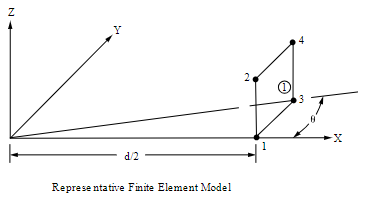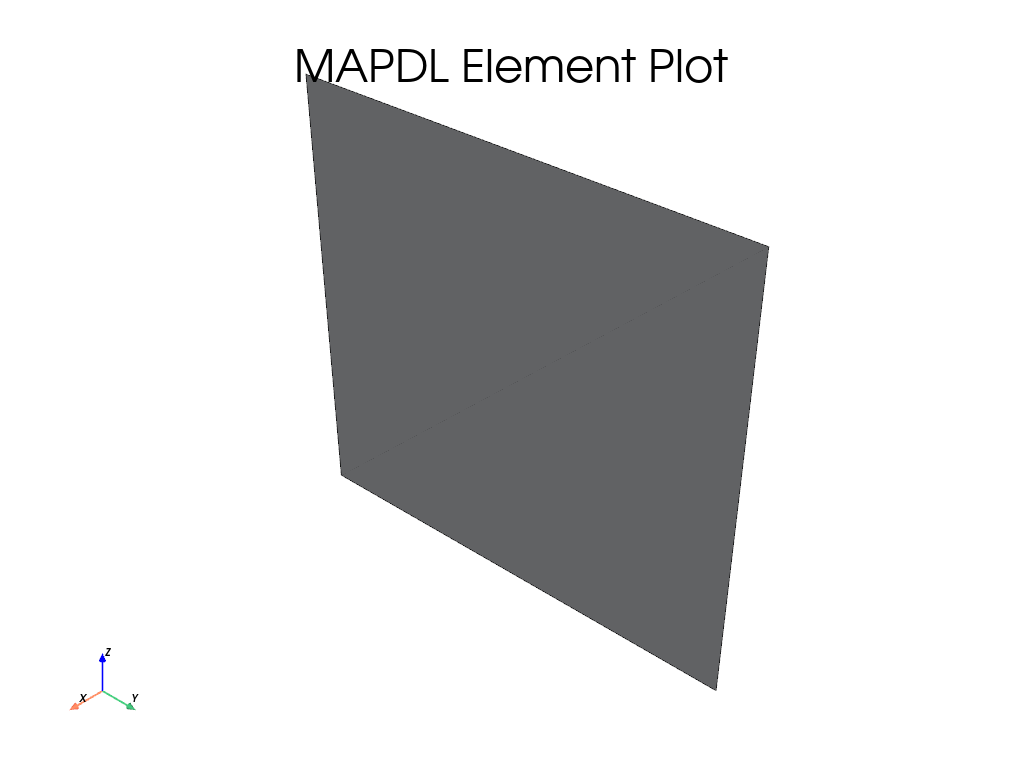Note
Go to the end to download the full example code.
Cylindrical Membrane Under Pressure#
- Problem description:
A long cylindrical membrane container of diameter d and wall thickness t is subjected to a uniform internal pressure P. Determine the axial stress \(\sigma_1\) and the hoop stress \(\sigma_2\) in the container. See VM13 for the problem sketch.
- Reference:
S. Timoshenko, Strength of Materials, Part II, Elementary Theory and Problems, 3rd Edition, D. Van Nostrand Co., Inc., New York, NY, 1956, pg. 121, article 25.
- Analysis type(s):
Static Analysis
ANTYPE=0
- Element type(s):
4-Node Finite Strain Shell Elements (SHELL181)

- Material properties:
\(E = 30 \cdot 10^6 psi\)
\(\mu = 0.3\)
- Geometric properties:
\(d = 120 in\)
\(t = 1 in\)
- Loading:
\(p = 500 psi\)
- Analysis Assumptions and Modeling Notes:
An arbitrary axial length is selected. Since the problem is axisymmetric, only a one element sector is needed. A small angle \(\theta\) = 10° is used for approximating the circular boundary with a straight-sided element. Nodal coupling is used at the boundaries. An axial traction of 15,000 psi is applied to the edge of the element to simulate the closed-end effect. The internal pressure is applied as an equivalent negative pressure on the exterior (face 1) of the element.
# sphinx_gallery_thumbnail_path = '_static/vm20_setup.png'
# Importing the `launch_mapdl` function from the `ansys.mapdl.core` module
from ansys.mapdl.core import launch_mapdl
import numpy as np
import pandas as pd
# Launch MAPDL with specified options
mapdl = launch_mapdl(loglevel="WARNING", print_com=True, remove_temp_dir_on_exit=True)
# Clear the existing database
mapdl.clear()
# Run the FINISH command to exists normally from a processor
mapdl.finish()
# Set the ANSYS version
mapdl.com("ANSYS MEDIA REL. 2022R2 (05/13/2022) REF. VERIF. MANUAL: REL. 2022R2")
# Run the VM20 verification
mapdl.run("/VERIFY,VM20")
# Set the analysis title
mapdl.title("VM20 CYLINDRICAL MEMBRANE UNDER PRESSURE")
# Enter the model creation /Prep7 preprocessor
mapdl.prep7()
/COM,ANSYS MEDIA REL. 2022R2 (05/13/2022) REF. VERIF. MANUAL: REL. 2022R2
*****MAPDL VERIFICATION RUN ONLY*****
DO NOT USE RESULTS FOR PRODUCTION
***** MAPDL ANALYSIS DEFINITION (PREP7) *****
Define element type and section properties#
Use 4-Node Structural Shell element (SHELL181) for finite strain membrane. Specify key option for membrane stiffness only via setting Keyopt(1)=1. Include full integration via setting Keyopt(3)=2.
mapdl.et(1, "SHELL181") # Define element type as SHELL181
mapdl.keyopt(1, 1, 1) # Set key option for membrane stiffness only
mapdl.keyopt(1, 3, 2) # Set key option for full integration
mapdl.sectype(1, "SHELL") # Section type SHELL
mapdl.secdata(1, 1) # Define section data
Shell Section ID= 1 Number of layers= 1 Total Thickness= 1.000000
Define material#
Set up the material and its type (a single material), Young’s modulus of 30e6 and Poisson’s ratio NUXY of 0.3 is specified.
mapdl.mp("EX", 1, 30e6) # Define modulus of elasticity
mapdl.mp("NUXY", 1, 0.3) # Define Poisson's ratio
MATERIAL 1 NUXY = 0.3000000
Define geometry#
Set up the nodes and elements. This creates a mesh just like in the problem setup.
mapdl.csys(1) # Define cylindrical coordinate system
mapdl.n(1, 60) # Define nodes
# Define additional node with translation
mapdl.n(2, 60, "", 10)
# Generate additional nodes from an existing pattern
mapdl.ngen(2, 2, 1, 2, 1, "", 10)
# Rotate nodal coordinate system to cylindrical
mapdl.nrotat("ALL")
# Define elements
mapdl.e(1, 2, 4, 3)
1
Define coupling and boundary conditions#
Apply couplings and fix UZ displacement at specific node and UY displacement for all nodes. Specify axial traction= -15000 psi and internal pressure= -500 psi on elements uaing SFE command. Then exit prep7 processor.
mapdl.cp(1, "UX", 1, 2, 3, 4) # Couple radial displacements
mapdl.cp(2, "UZ", 2, 4) # Couple UZ displacements
mapdl.d(1, "UZ", "", "", 3, 2) # Fix UZ displacement at specific node
mapdl.d("ALL", "UY") # Fix UY displacement for all nodes
mapdl.sfe(1, 4, "PRES", "", -15000) # Apply axial traction on elements
mapdl.sfe(1, 1, "PRES", "", -500) # Apply internal pressure on elements
# Selects all entities
mapdl.allsel()
# Element plot
mapdl.eplot(background="w")
# Finish the preprocessing steps
mapdl.finish()

***** ROUTINE COMPLETED ***** CP = 0.000
Solve#
Enter solution mode and solve the system.
mapdl.slashsolu()
# Set the analysis type to STATIC
mapdl.antype("STATIC")
mapdl.outpr("NSOL", 1) # Output the nodal solution
mapdl.outpr("RSOL", 1) # Output the result summary
# Perform the solution
mapdl.solve()
# exists solution processor
mapdl.finish()
FINISH SOLUTION PROCESSING
*** NOTE *** CP = 0.000 TIME= 00:00:00
Distributed parallel processing has been reactivated.
***** ROUTINE COMPLETED ***** CP = 0.000
Post-processing#
Enter post-processing. Compute stress quantities.
Verify the results.#
# Set target values
target_stress = [15000, 29749]
# Fill result values
sim_res = [strs_hop, strs_ax]
col_headers = ["TARGET", "Mechanical APDL", "RATIO"]
row_headers = ["Stress_1 (psi)", "Stress_2 (psi)"]
data = [target_stress, sim_res, np.abs(target_stress) / np.abs(sim_res)]
title = f"""
------------------- VM20 RESULTS COMPARISON ---------------------
"""
print(title)
print(pd.DataFrame(np.transpose(data), row_headers, col_headers))
------------------- VM20 RESULTS COMPARISON ---------------------
TARGET Mechanical APDL RATIO
Stress_1 (psi) 15000.0 15000.0000 1.000000
Stress_2 (psi) 29749.0 29885.8418 0.995421
Finish the post-processing processor.#
mapdl.finish()
EXIT THE MAPDL POST1 DATABASE PROCESSOR
***** ROUTINE COMPLETED ***** CP = 0.000
Stop MAPDL.#
mapdl.exit()
Total running time of the script: (0 minutes 0.879 seconds)

